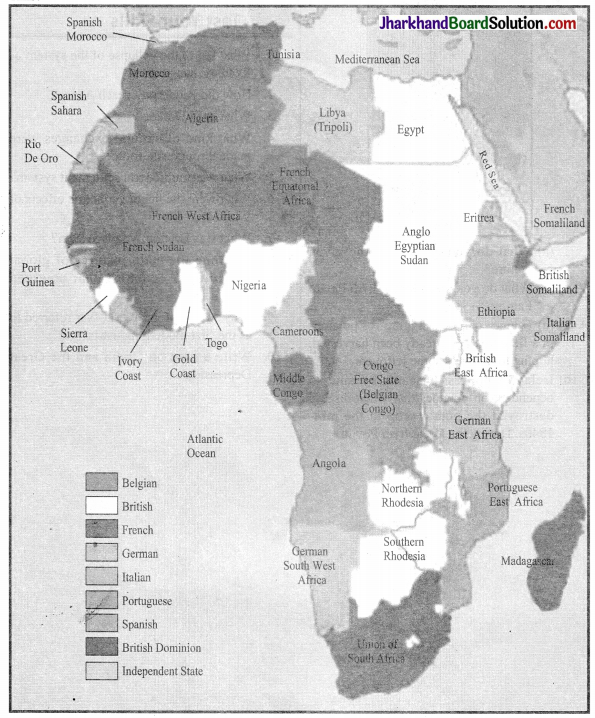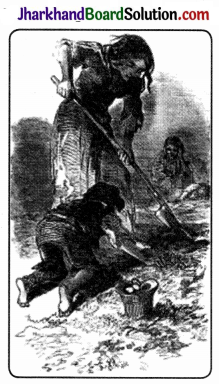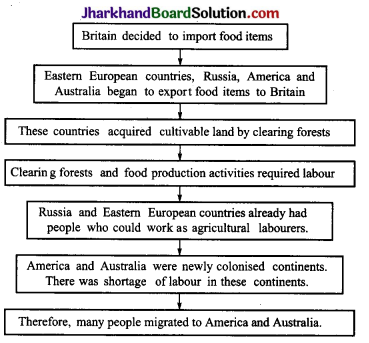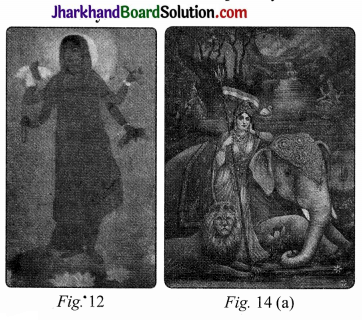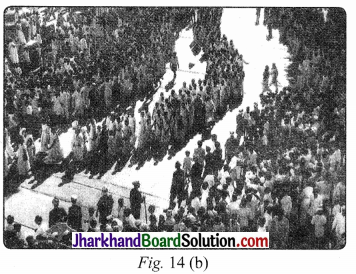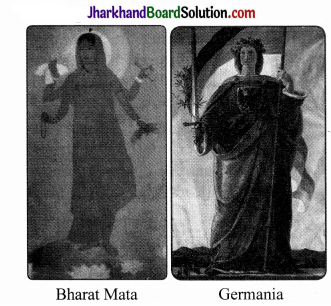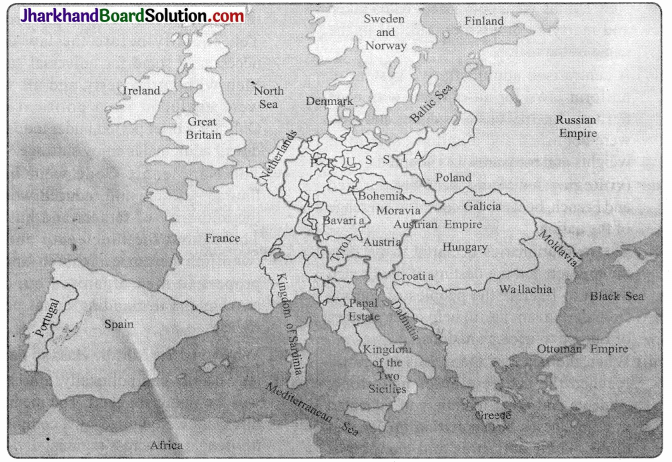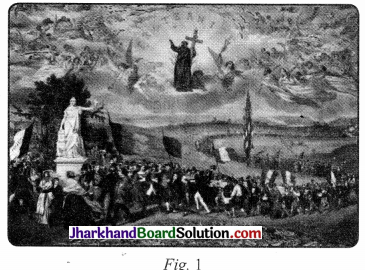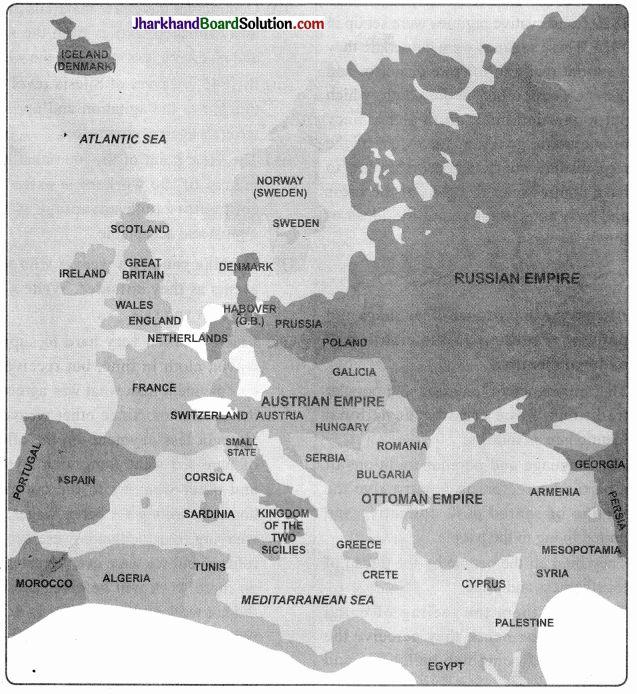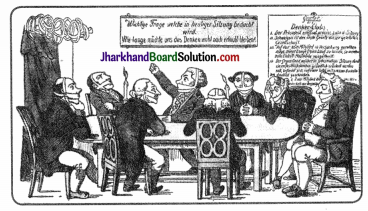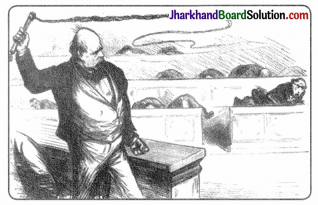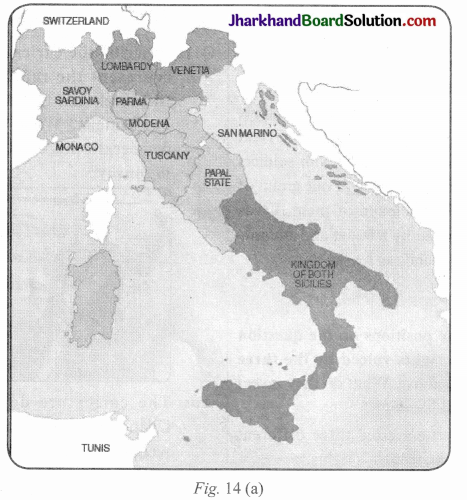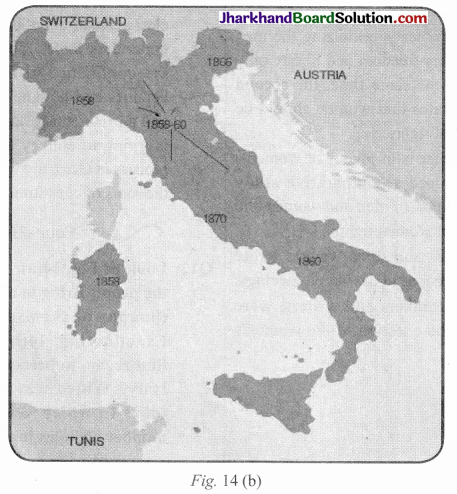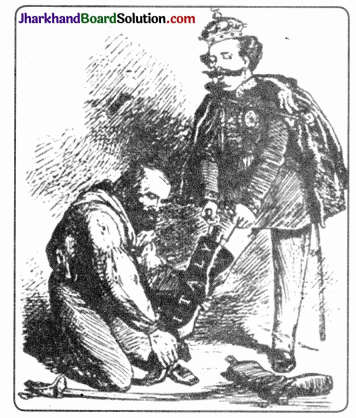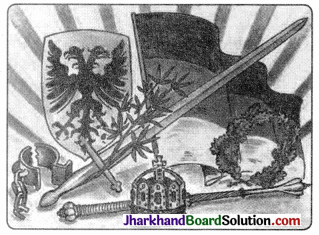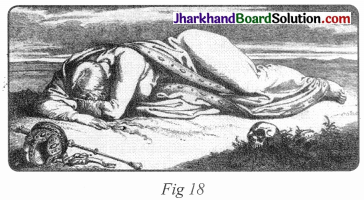JAC Board Class 10th Social Science Important Questions History Chapter 2 Nationalism in India
Multiple Choice Questions
Question 1.
In which year did Mahatma Gandhi decide to launch a nationwide satyagraha against the proposed Rowlatt Act (1919)?
(a) 1919
(b) 1920
(c) 1921
(d) 1930
Answer:
(a) 1919

Question 2.
Where was the Khilafat Committee formed in March 1919?
(a) Aligarh
(b) Poona
(c) Bombay
(d) Nagpur
Answer:
(c) Bombay
Question 3.
When did the Jallianwala Bagh incident take place?
(a) 13 April 1919
(b) 13 April 1920
(c) 26 January 1930
(d) 11 March 1931
Answer:
(a) 13 April 1919
Question 4.
Who was the spiritual head of the Islamic world?
(a) Abdul Ghaffar Khan
(b) The Khalifa
(c) ShaukatAli
(d) Muhammad Ali Jinnah
Answer:
(b) The Khalifa
Question 5.
Where was the demand for ‘Purna Swaraj’ formalised?
(a) Congress Session, Calcutta (September 1920)
(b) Congress Session, Nagpur (December 1920)
(c) Congress Session, Madras (1927)
(d) Congress Session, Lahore (1929)
Answer:
(d) Congress Session, Lahore (1929)
Question 6.
How was the Simon Commission greeted in India?
(a) Question: uit India Movement
(b) ‘Go back Simon’
(c) Dandi March
(d) Gandhi-Irwin Pact
Answer:
(b) ‘Go back Simon’

Question 7.
Who announced a vague offer of ‘dominion status’ for India?
(a) Lord Irwin
(b) General Dyer
(c) Sir John Simon
(d) Henry Mayhew
Answer:
(a) Lord Irwin
Question 8.
Who is one of the industrialists who supported the Civil Disobedience Movement?
(a) Kumar Mangalam Birla
(b) Ananya Birla
(c) GautamAdani
(d) G.D. Birla
Answer:
(d) G.D. Birla
Question 9.
What did Gandhiji call the untouchables?
(a) Sanatanis
(b) Scheduled Castes
(c) Harijan
(d) Depressed Class
Answer:
(d) Depressed Class
Question 10.
Who was the first to create an image of Bharat Mata? ‘
(a) Jawaharlal Nehru
(b) Bankim Chandra Chattopadhyay
(c) Rabindranath Tagore
(d) Abanindranath Tagore
Answer:
(b) Bankim Chandra Chattopadhyay
Question 11.
Who wrote ‘Vande Mataram’?
(a) Bankim Chandra Chattopadhyay
(b) Rabindranath Tagore
(c) Abanindranath Tagore
(d) Natesa Sastri
Answer:
(a) Bankim Chandra Chattopadhyay
Question 12.
In whieh novel was ‘Vande Mataram’ included?
(a) Rangbhoomi
(b) Durgeshnandini
(c) Godan
(d) Anandamath
Answer:
(d) Anandamath
Question 13.
Who painted Bankim Chandra Chattopadhyay’s famous image of Bharat Mata?
(a) Rabindranath Tagore
(b) Mahatma Gandhi
(c) Abanindranath Tagore
(d) Natesa Sastri
Answer:
(c) Abanindranath Tagore
Question 14.
Who designed the Swaraj Flag which was a tricolour and had a spinning wheel in the centre?
(a) Abanindranath Tagore
(b) G.D. Birla
(c) Purshottamdas Thakurdas
(d) Mahatma Gandhi
Answer:
(d) Mahatma Gandhi
Question 15.
Who believed that folklore was national literature?
(a) Natesa Sastri
(b) G.D. Birla
(c) Bal Gangadhar Tilak
(d) Abdul Ghaffar Khan
Answer:
(a) Natesa Sastri
Very Short Answer Type Questions
Question 1.
Explain Bardoli Satyagarha?
Answer:
- In 1928, Vallabhbhai Patel led the peasant movement in Bardoli, a taluka in Gujarat, against enhancement of land revenue.
- Bardoli Satyagraha movement was a success under the leadership of Vallabhbhai Patel.
- The struggle was widely publicised and generated immense sympathy in many parts of India.
Question 2.
What was the idea of satyagraha?
Answer:
The idea of satyagraha emphasised the power of truth and the need to search for truth.

Question 3.
What was the forced recruitment?
Answer:
It was a process through which the colonial state forced the people, especially people from the rural areas, to join the army.
Question 4.
Where did Mahatma Gandhi organise successful satyagraha movements in 1916 and 1917?
Answer:
(i) In 1916, Mahatma Gandhi inspired the peasants of Champaran, Bihar to struggle against the oppressive plantation system.
(ii) In 1917, he organised a satyagraha to support the peasants of the Kheda district of Gujarat, who were affected by crop failure and plague epidemic, and could not pay the revenue and demanded relaxation of revenue collection.
(iii) In 1918 Mahatma Gandhi went to Ahemdabad to organise a satyagraha movement amongst cotton mill workers.
Question 4.
What is the Rowlatt Act, 1919?
Answer:
The Rowlatt Act, 1919 was hurriedly passed through the Imperial Legislative Council despite the united opposition of the Indian members. It gave the government enormous powers to repress political activities and allowed detention of political prisoners without trial for two years.
Question 5.
What did Gandhiji declare ajbout the British rule in India in his book Hind Swaraj (1909)?
Answer:
Mahatma Gandhi in his famous book Hind Swaraj declared that the British rule was established in India with the cooperation of Indians, and had survived only because of this ‘cooperation. If Indians refused to cooperate, British rule in India would collapse within a year, and swaraj would come.
Question 6.
What was the first step that Gandhiji proposed so that non-cooperation could become a movement?
Answer:
Gandhiji proposed that the non¬cooperation movement should begin with the surrender of titles that the government awarded, and a boycott of civil services, army, police, courts and legislative councils, schools and foreign goods.
Question 7.
What was the demand of the peasant movement?
Answer:
The peasant movement demanded reduction of revenue, abolition of begar and social boycott of oppressive landlords. In many places nai-dhobi bandhs were organised by panchayats to deprive landlords of the services of even barbers and washermen.
Question 8.
Who set up the Oudh Kisan Sabha?
Answer:
In June 1920, Jawaharlal Nehru began going around the villages in Awadh to talk with them and understand their problems. By October, the Oudh Kisan Sabha was set up by Jawaharlal Nehru, Baba Ramchandra and a few others.

Question 9.
When was the demand for ‘Purna Swaraj’ made?
Answer:
In December 1929, under the presidency of Jawaharlal Nehru, the Lahore Congress formalised the demand for ‘Puma Swaraj’ or full independence for India.
Question 10.
What, according to Mahatma Gandhi was the most oppressive face of British rule?
Answer:
The tax on salt law and the government monopoly over its production, Mahatma Gandhi declared, revealed the most oppressive face of British rule.
Short Answer Type Questions
Question 1.
Mention three main proposals with reference to Non-Cooperation Movement, as suggested by Mahatma Gandhi.
Answer:
Gandhiji suggested that the Non Cooperation Movement should be carried out in stages:
- It should begin with the surrender of titles that the government awarded.
- The civil services, army, police, courts, legislative councils, schools and foreign goods should be boycotted.
- In case the government used repression, a full civil disobedience campaign would be launched.
Through the summer of 1920, Mahatma Gandhi and Shaukat Ali toured extensively, mobilising popular support for the movement.
Question 2.
How did people react to the Jallianwala Bagh incident?
Answer:
Hundreds of people were killed in the Jallianwala Bagh incident. In many north Indian towns, people gathered on the streets. There were strikes, clashes with the police and attacks on government buildings. The government responded with brutal repression, seeking to humiliate and terrorise people. Satyagrahis were forced to rub their noses on the ground, crawl on the streets and salute to all sahibs. People were flogged, and villages around Gujranwala in Punjab and now Pakistan were bombed.
Question 3.
What were the effects of Non-Cooperation Movement on the economic front?
Answer:
Foreign goods were boycotted; liquor shops picketed and foreign clothes were burnt in huge bonfires. The import of foreign cloth halved between 1921 and 1922, its value dropping from ? 102 crore to ? 57 crore. In many places merchants and traders refused to trade in foreign goods or finance foreign trade. As the boycott movement spread, and people began discarding imported clothes and wearing-only Indian ones, production of Indian textile mills and handlooms went up.
Question 4.
Give reasons for the slow down of Non-Cooperation Movement in the cities.
Answer:
The Nob Cooperation Movement slowed down in the cities for a variety of reasons. Khadi cloth was often more expensive than mass-produced mill cloth and poor people could not afford to buy it. Similarly, the boycott of British institutions posed a problem. For the movement to be successful, alternative Indian institutions had to be set up so that they could be used in place of British ones. These were slow to come up. Therefore, students and teachers began returning to government schools and lawyers joined back work in government courts.
Question 5.
Who spearheaded the movement of tribal peasants? How was the move¬ment carried out?
Answer:
Alluri Sitaram Raju led the tribal peasants in the Gudem Hills of Andhra Pradesh in the movement. He talked of the greatness of Mahatma Gandhi and was inspired by the Non-Cooperation Movement. He persuaded people to wear khadi and give up drinking. However, he also asserted that India could be liberated only by the use of force, not non-violence. The Gudem rebels attacked police stations, attempted to kill British officials and carried on guerrilla warfare for achieving swaraj.
Question 6.
Why did Gandhiji decide to withdraw the Non-Cooperation Movement in February 1922?
Answer:
At Chauri Chaura in Gorakhpur, a peaceful demonstration in a bazaar turned into a violent clash with the police. Hearing this, Gandhiji decided to call off the Non-Cooperation Movement. He felt that the movement was turning violent in many places and satyagrahis needed to be properly trained before they would be ready for mass struggles. Also within the Congress, some leaders were tired of mass struggles and wanted to participate in elections to the provincial councils that had been set up by the Government of India Act of 1919.

Question 7.
Give the significance of Lahore Congress of December 1929.
Answer:
In December 1929, under the presidency of Jawaharlal Nehru, the Lahore Congress formalised the demand of ‘Puma Swaraj’ or full independence for India. It was declared that 26 January 1930 would be celebrated as the Independence Day when ’ people were to take a pledge to struggle for complete independence. Therefore, Mahatma Gandhi had to device ways to relate this abstract idea of freedom to concrete issues of every day life to strengthen the struggle for freedom.
Question 8.
Why did Gandhiji decide to re-launch the Civil Disobedience Movement?
Answer:
After the Gandhi-Irwin Pact, Gandhiji consented to participate in the Round Table Conference in London and the government agreed to release the political prisoners. However, when Gandhiji went to London for the conference in December 1931, the negotiations broke down and he returned disappointed. The government had begun a new cycle of repression. Ghaffar Khan and Jawaharlal Nehru were in jail, and Congress had been declared illegal. Series of measures were taken to prevent meetings, demonstrations and boycotts. With great apprehension, Gandhiji relaunched the Civil Disobedience Movement.*
Question 10.
Why was the Congress reluctant to include workers’ demands as part of its programme of struggle?
Answer:
The Congress was reluctant to include workers’ demands as part of its programme -of struggle because:
- The industrial working classes did not participate in the Civil Disobedience Movement in large numbers, except in the Nagpur region.
- As the industrialists came closer to the Congress, the workers stayed aloof.
- The Congress felt that including the workers’ demands as part of its programme of struggle would alienate industrialists and divide the anti-imperial forces.
Long Answer Type Questions
Question 1.
What was one of the ways Gandhiji thought could bring the Hindus and Muslims closer together for a broad based movement in India?
Answer:
- The First World War ended with the defeat of Ottoman Turkey and rumours that a harsh peace treaty was going to be imposed on the Ottoman emperor.
- To defend the Khalifa’s temporal powers, a Khilafat Committee was formed in Bombay in March 1919. Young Muslim leaders, brothers Muhammad Ali and Shaukat Ali discussed a possibility of mass action on the issue.
- Gandhiji took this as an opportunity to bring the Muslims under the umbrella of a unified national movement.
- At the Congress Session in Calcutta, 1920, Gandhiji convinced other leaders to start a non-cooperation movement in support of Khilafat as well as for swaraj.
Question. 2.
How did the peasants of Awadh participate in the Non-Cooperation Movement?
Answer:
(i) In Awadh, Baba Ramchandra led the peasants against talukdars and landlords who demanded from peasants exorbitantly high rents and a variety of other cesses, and forced them to do begar.
(ii) The peasants demanded reduction of revenue, abolition of begar and social boycott of oppressive landlords.
(iii) Oudh Kisan Sabha, headed by Jawaharlal Nehru, Baba Ramchandra and a few others was set up by October 1920 and within a month 300 branches opened around the region.
(iv) When the Non-Cooperation Movement began the next year, the Congress made efforts to integrate Awadh peasant struggle into the wider struggle.
(iv) The houses of talukdars and merchants were attacked, bazaars were looted, and
grain hoards were taken over. In many places, local leaders told peasants that Gandhiji had declared that no taxes were to be paid and land was to be redistributed among the poor.
(v) The name of the Mahatma was being invoked to sanction all action and aspirations.

Question. 3.
What was the understanding of Mahatma Gandhi and notion of swaraj for the plantation workers?
Answer:
(i) For the plantation workers in Assam, freedom meant the right to move freely in and out of confined space in which they were enclosed, and it meant retaining a link with the village from which they had come.
(ii) The Inland Emigration Act of 1859 did not permit the plantation workers to leave the tea gardens without permission.
(iii) When they heard about the Non Cooperation Movement, they defied the authorities, left the plantations and headed home.
(iv) They believed Gandhi Raj was coming and everyone would be given land in their own villages. They never reached their destination.
(v) Stranded on the way by a railway and steamer strike, they were caught by the police and brutally beaten up.
Question. 4.
Why was Simon Commission greeted with resistance?
Answer:
The new Tory government in Britain constituted a Statutory Commission under Sif John Simon. It was set up in response to the nationalist movement. The commission was to look into the functioning of the constitutional system in India.aild suggest changes. The concern was that the commission did not have a single Indian member. They were all British. Therefore, when the Simon Commission came to India, they were greeted with the slogan ‘Go back Simon’. All parties, including the Congress and the Muslim League, participated in the
demonstrations.
Question 5.
Discuss how ‘Salt March’ became an effective tool of resistance against colonialism?
Answer:
(i) Gandhiji revealed that the tax on salt and the government monopoly over its production was the most oppressive face of British rule. On 31 January, 1930
(ii) Gandhiji sent a letter to Viceroy Irwin with eleven demands and stating that a Civil Disobedience Movement would be launched if the demands were not met.
(iii) These demands were wide-ranging so that all classes of the Indian society could identify with them and come together for a united campaign.
(iv) When Irwin refused to negotiate, Gandhiji started the Salt March with 78 volunteers. After marching for 240 miles from Sabarmati Ashram, they reached Dandi on 6 April and violated the salt law, manufacturing salt by boiling sea water.
(v) People were asked to refuse cooperation with the British and also break colonial laws.
(vi) Demonstrations were held in front of government salt factories, foreign cloth was boycotted, and liquor shops picketed, i
peasants refused to pay revenue and chaukidari taxes, village officials resigned and forest laws were violated.

Question 6.
Describe the difference in approach of Mahatma Gandhi and Dalit leaders regarding the ‘untouchables’.
Answer:
(i) Gandhiji believed that swaraj would not come if untouchability was not eliminated. He called the ‘untouchables’ harijan, organised satyagraha to secure their entry into temples and access to public wells, tanks, roads and schools.
(ii) He himself cleaned toilets to dignify the
(iii) But the dalit leaders were keen on a different political solution to the problems of the community. They began organising and demanded reserved seats in educational institutions, and a separate electorate that would choose the dalit members for legislative councils.
(iv) They considered political empowerment as a solution to their social disabilities.
(v) Dalit participation in Civil Disobedience Movement was very limited, especially in Maharashtra and Nagpur region where their organisation was very strong.
Question. 7.
Discuss the Poona Pact of 1932.
Answer:
(i) Dr. B.R. Ambedkar, organised the dalits into the Depressed Classes Association in 1930, differed with Mahatma Gandhi at the second Round Table Conference by demanding separate electorates for dalits.
(ii) When the British government agreed to Ambedkar’s demand, Gandhiji began a fast unto death.
(iii) He believed that separate electorates for dalits would slow down the process of their integration into society.
(iv) Ambedkar finally accepted Gandhiji’s position and the result was the Poona Pact of September 1932.
(v) The Depressed Classes, later known as Scheduled Castes, were provided reserved seats in provincial and central legislative councils, but they were to be voted in by the general electorate.
Question 8.
The identity of the nation is most often symbolised in a figure or image. Justify.
Answer:
- It was in the twentieth century, with the growth of nationalism, that the identity ‘ of India came to be visually associated with the image of Bharat Mata.
- The image was first created by Bankim Chandra Chattopadhyay. In the 1870s, he wrote ‘Vande Mataram’ as a hymn to the motherland.
- Later it was included in his novel Anandamath and widely sung during the Swadeshi movement in Bengal. Moved by the Swadeshi movement, Abanindranath Tagore painted his famous image of Bharat Mata.
- In his painting, Bharat Mata is portrayed as an ascetic figure; she is calm, composed, divine and spiritual.
- In the subsequent years, the image of Bharat Mata acquired many different forms, as it circulated in popular prints and were painted by different artists.
- Devotion to this mother figure came to be seen as evidence of one’s nationalism.
Question 9.
Write a short note on Quit India Movement?
OR
‘The failure of the Cripps Mission and the effects of World War II created widespread discontentment in India.’ Justify the statement
Answer:
Gandhiji launched a movement calling for complete withdrawal of the British from India:
(i) The Congress Working committee, at Wardha on 14 July 1942, passed the ‘Question: uit India’ resolution demanding the immediate transfer of power to Indians and quit India.
(ii) On 8 August 1942 in Bombay, the all India Congress Committee passed the resolution launching non-violent mass struggle on the widest possible scale throughout the country.
(iii) Gandhiji delivered the famous ‘Do or Die’ speech. The call for ‘Question: uit India’ almost brought the state machinery to a standstill in large parts of the country.
(iv) People observed hartals, demonstrations and processions singing national songs and slogans.
(v) The movement was truly a mass movement in which thousands of students, workers and peasants, leaders like Jayprakash Narayan, Aruna Asaf Ali and Ram Manohar Lohia and many women like Matangini Hazra in Bangal; Kanaklata Barua in Assam and Rama Devi in Odisha actively participated.
(vi) The British responded with much force, yet it took more than a year to suppress the movement.
Activity Based Questions
Question 1.
Four places a, b, c, and d are marked on the outline political map of India. Identify these places with the help of the following information and write their correct names on the lines marked near them:
(a) Locate and name the place where Indian National Congress Session was held in September 1920.
(b) Locate and name the place where Indian National Congress Session was held in December 1920.
(c) Locate and name the place where Indian National Congress Session was held in 1927.
Answer:
(a) Calcutta, September 1920
(b) Nagpur, December 1920
(c) Madras, 1920
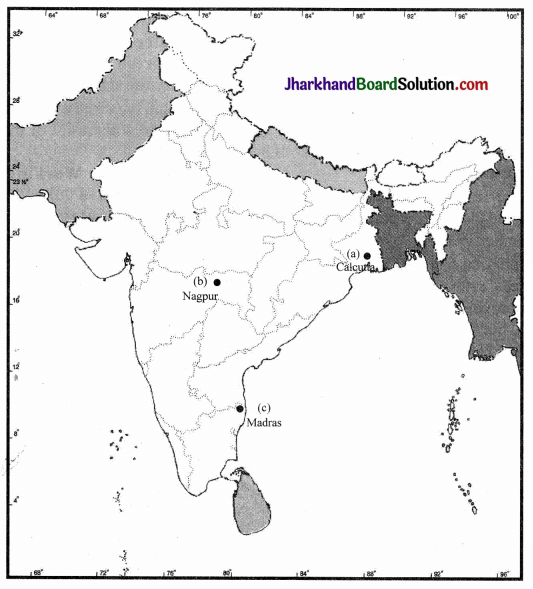
Question 2.
Important centres of Indian National Movement are marked on the outline political map of India. Identify these places with the help of following information and write their correct names on the lines marked near them:
(a) The place where there was a movement by Indigo planters.
(b) The place where Peasant Satyagraha was held.
(c) The place where cotton mill workers organised Satyagraha.
(d) The place where Jallianwala Bagh incident took place.
(e) The incident in Uttar Pradesh that led to calling off the Non-Cooperation Movement.
(f) Civil Disobedience Movement began here.
Answer:
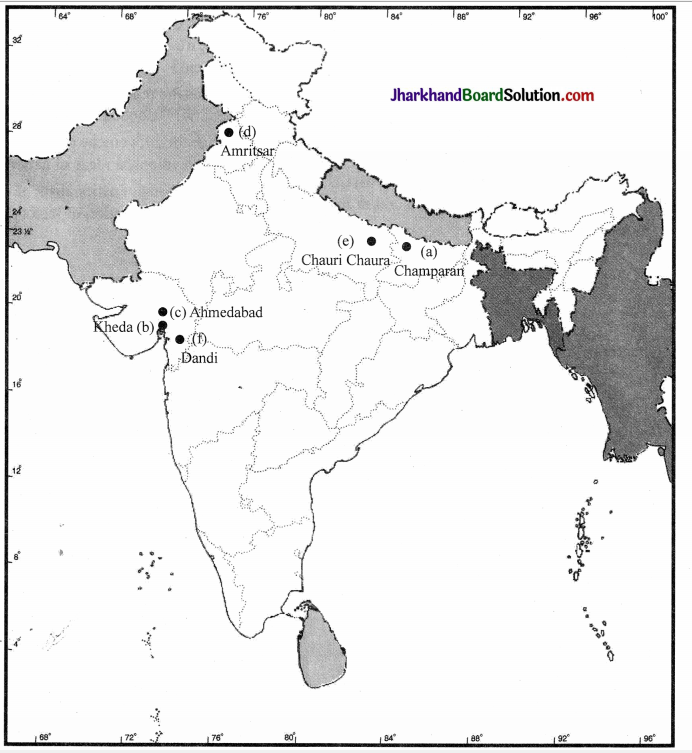
(a) Champaran (Bihar) – Movement of Indigo planters
(b) Kheda (Gujarat) – Peasant Satyagraha
(c) Ahmedabad (Gujarat) – Cotton Mill Workers Satyagraha
(d) Amritsar (Punjab) – Jallianwala Bagh incident
(e) Chauri Chaura (Uttar Pradesh) – Calling off Non-Cooperation Movement
(f) Dandi (Gujarat) – Civil Disobedience Movement
![]()
![]()
